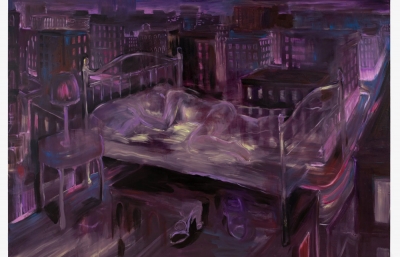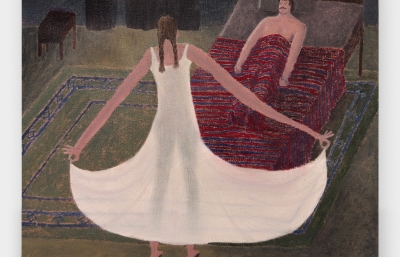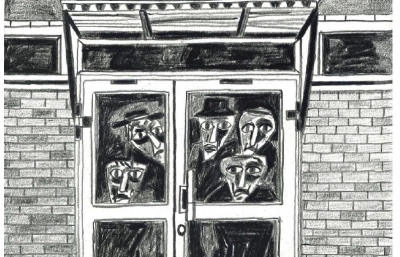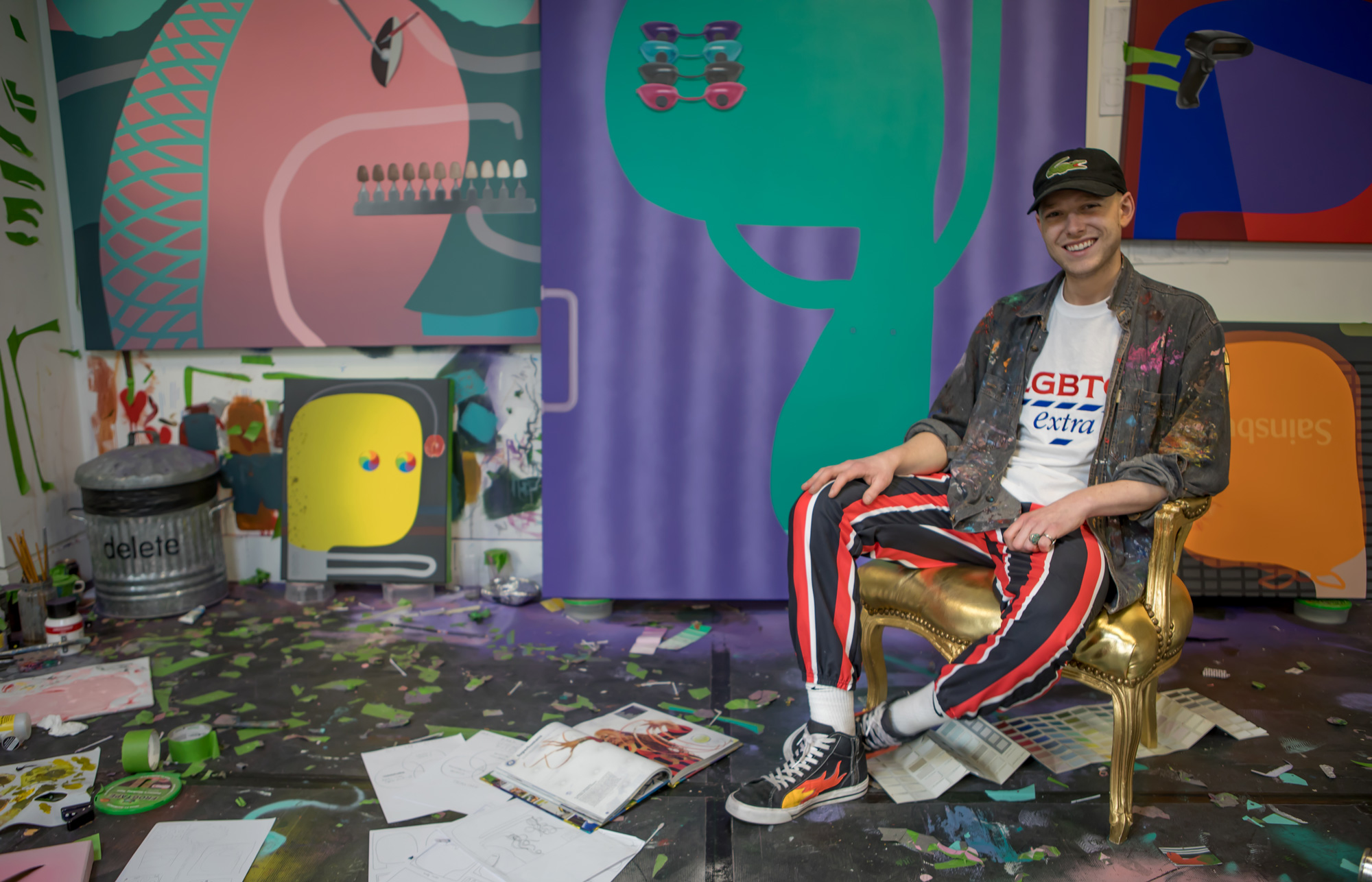
Oli Epp
Carpe Diem, Kid
Interview by Kristin Farr // Portrait by Ian Cox
In the movie of your life, Oli Epp paints the extras, most notably, himself. This London artist took the gold in figurative freshness this year, with unique portraits and moments cropped and oddly abstracted, much like random memories—they’re vaporous. On the topic of being half in and half out, the duality of digital and real life is another facet of the artist’s exploration, digging into our values, subtly exposing our motives and anxieties. His art shines a light on the significance of a new generation’s everyman, elevating the mundanity of daily existence, often with a wry wink, a wise nod, and a sun-tanned bod.
Kristin Farr: Tell me about these beings you paint. Are they people? Do they have souls?
Oli Epp: They’re everyone and no one. They’re a mirror of our consumer selves. Featureless, two-dimensional, often superficial; they’re attracted to the things which are artificial in our world, material things. But they are born from how we experience identity online; often anonymous and changeable.
They’re defined by their choices. Most of the intimate portraits of these characters are within arms reach of a selfie stick. They might not have expressions but they have aspirations and desires. In my world, the Guinness Book of World Records is the Bible. I find humour in the pathos of these characters trying to reach beyond their two-dimensional limits.
They appear self-conscious but they don’t have a self to be conscious about—in this way my paintings selfie the selfie—they reflect on our desire to externally stage our inner lives through the misdirections of the screen.
I love the reference in Buttercup, since I remember doing that buttercup test as a kid. Do you naturally tap into nostalgia, or is it more calculated or symbolic?
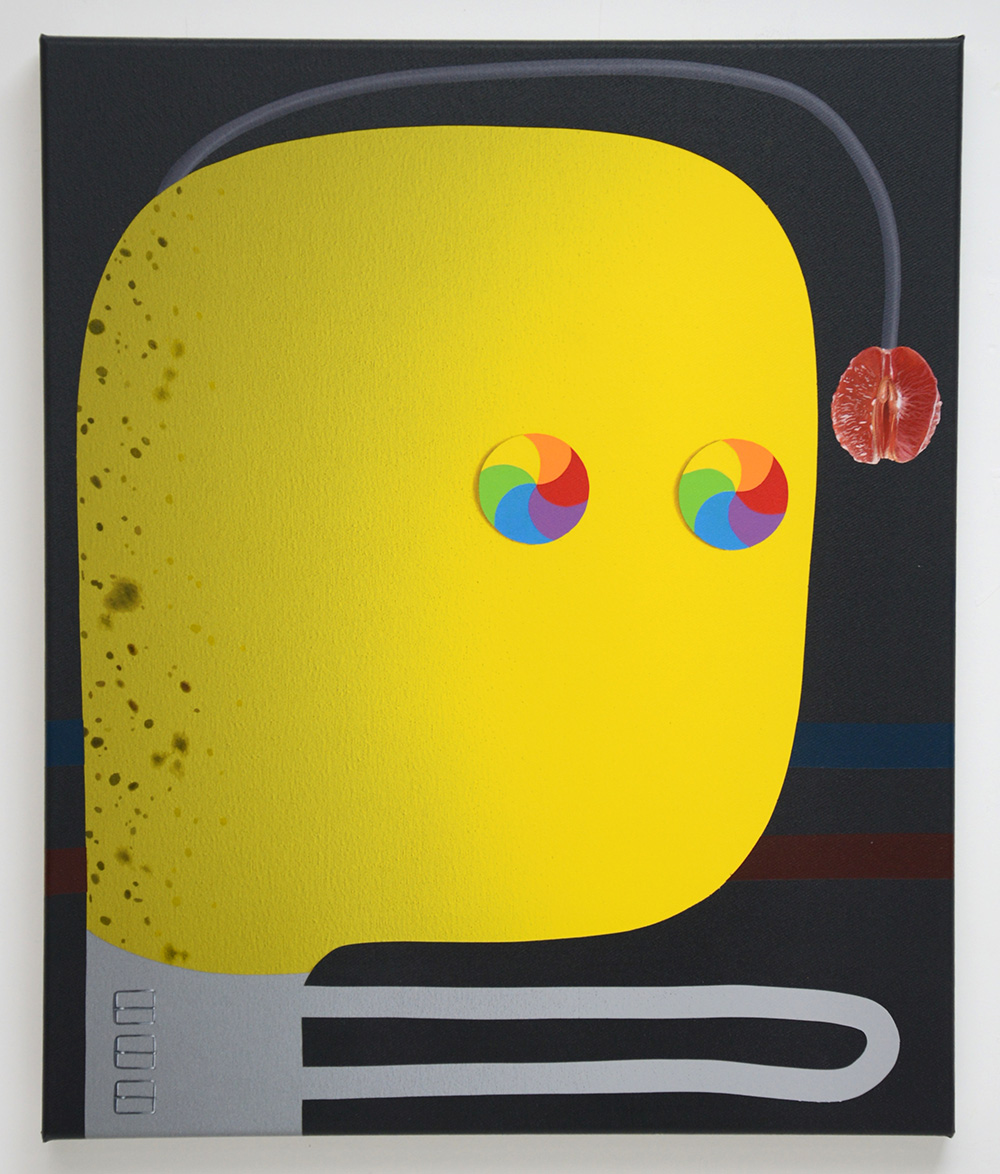
I think about my childhood a lot when I’m drawing. Childhood is a universal experience, which evokes nostalgia in all of us. Cartoons activate this as well, and I like to draw upon that. I feel like the cartoon is a powerful tool through which to talk about subjects that we might find difficult: social divisions, sex, vanity, etc.
What are some examples of real life, everyday moments that inspired specific parts of paintings?
A lot of my work is derived from personal experiences; things I have either witnessed or taken part in. Ultra Vain and Aftersun are sunbed paintings. Last November, I had the holiday blues, so I decided to get an unlimited monthly package at the tanning shop, because I like to make the most of an offer. I went religiously every day, and I was unseasonably tanned for the winter season.
From the surprise of a static shock, the humiliation of hiding a hickey, that desperate attempt to be better, to that feeling of anger when someone reclines their seat in front of you on an economy flight, there’s inspiration everywhere.
Is the hickey on the figure in Carpe Diem from personal experience?
Yes, I have had a hickey before, but my paintings are a mixture of firsthand experience and observations. However, that painting was a response to the 24-hour McDonald’s drive-thru I just moved next to. From my window, I can see cars orbiting the place into the early hours of the morning. In my work, I’m interested in this fast consumer culture. I render realistic objects on the surface of my paintings, ready for consumption and enjoyment.
Is there part of the process where you stare at the piece forever and contemplate whether it needs an earring or a hickey?
I deliberate at length over the smallest of decisions. I’m constantly thinking about composition. Clarity is important to my work. However, I’m beginning to enjoy confusing the viewer with my imagery; on the one hand, I want to make a clear dynamic and impactful image, but on the other hand, I want something which reveals itself slowly, with greater complexity, to come through. I like it when my works have a slower discovery time
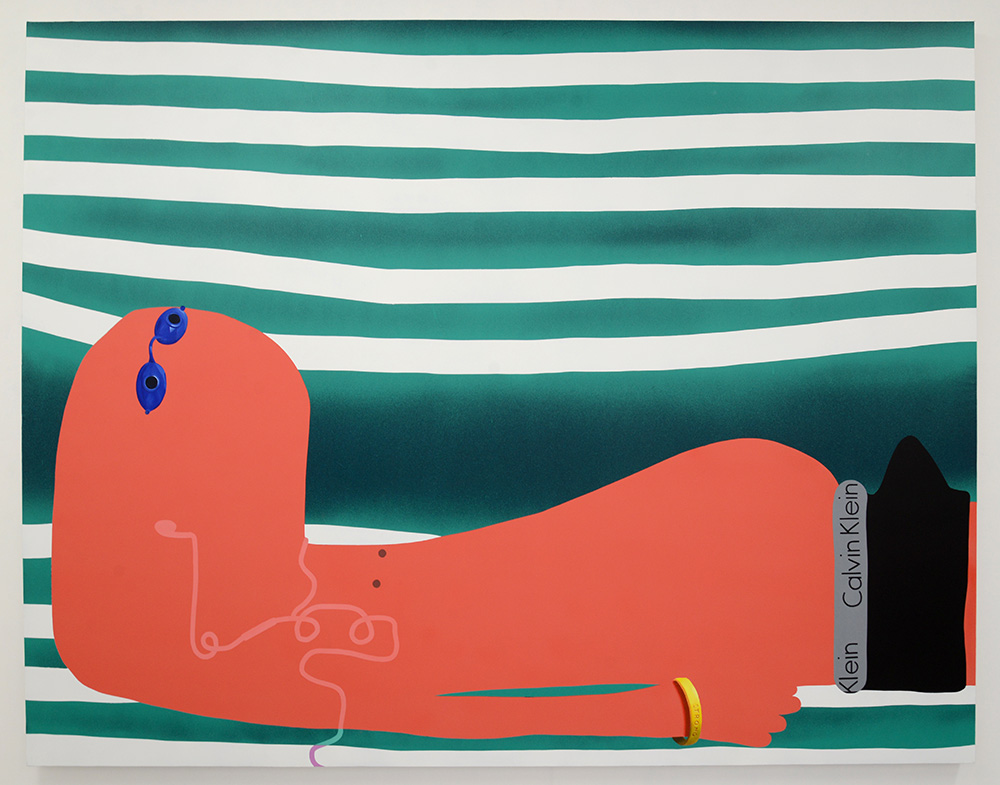
What are the most formalistic things you consider when painting?
Principally, I think about flat bold planes of colour, clean sharp edges, punctuations of detail and moments of realism either floating on or embedded in the surface.
The realism moments are startling, especially in Bag for Life. What made you start combining the abstracted and graphic with your realism skills?
I aspired to make very illusionistic portraits at art school, which were always heavily criticized. I guess I realised that I was simply borrowing the style of other artists and that meant I wasn’t putting my own voice into my work. Since then, I have been developing my own language by combining a vocabulary of different techniques and ideas, borrowing from the likes of Patrick Caulfield, Philip Guston and George Condo; I’m especially interested in what Condo has to say about “Artificial Realism.”
The act of reducing something to the simplest form possible that still communicates a full object or situation is fascinating, and that mastery seems to come naturally to you.
Well, I’m constantly looking at the grandaddies of Minimalism, like the greats, Ellsworth Kelly and Josef Albers. They’ve done most of the hard work work for us, in terms of understanding color relationships and compositional structures. I’m constantly borrowing my favorite elements of their work. In addition to that, I understand something about cartoon language, which allows me to distill situations down to their simplest form.
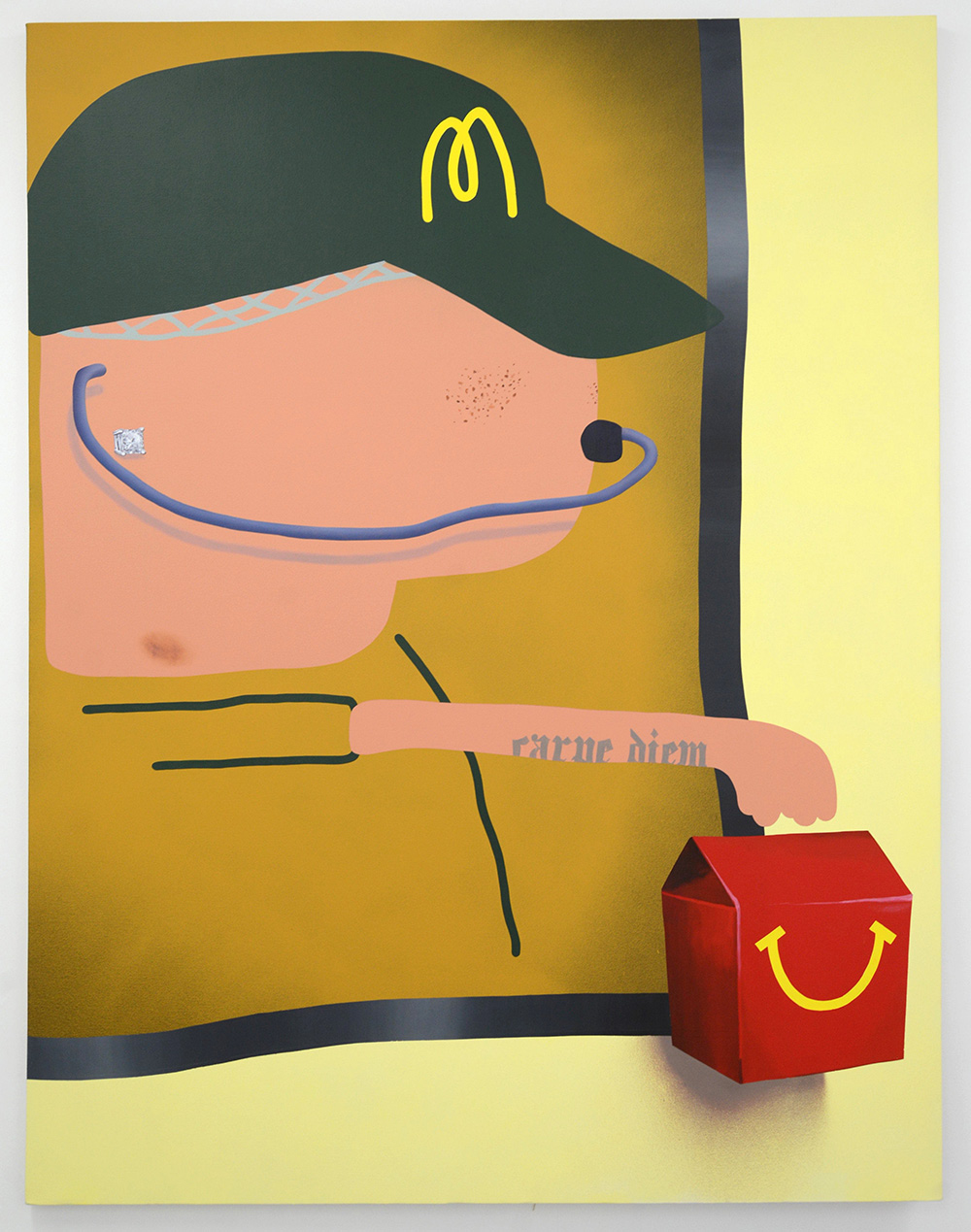
What kind of emotions do you tap into most often?
I like it when people smile at my paintings. Wayne Thiebaud once said, “artists are in the leisure industry,” and I agree with that. Most of my work has a bright, pop aesthetic, but under the surface of the paintings often lies a more tragic and sobering narrative.
Are the cigarettes symbolic? Do you smoke?
Yes, I smoke, and like many people, I wish I didn’t. For me, cigarettes are a symbol of addiction, objects which humans surrender to.
Art and smoking go hand-in-hand. Speaking of addiction, social media’s been part of your art networking system, and you grew up with it. What do you think is next? Will there be an enlightenment where everyone gets sick of the algorithm and throws their phone in a river?
I read this meme the other day, “Imagine they delete Instagram, and BOOM!!! You’re not an artist anymore.” It scared me but it also made me laugh—it was so spot on. I’ve managed to develop a following for my paintings online, and because of it, my work is able to reach tens of thousands of unique accounts each and every week. Even if Instagram does disappear, I have made great ties with artists, gallerists, curators, and collectors all around the globe. I feel it has given me a great head start.
Your sketches are digital and your paintings are oil, acrylic, and aerosol, so you’re a bridge across art histories. Drawing from photos is a way to immortalize them, but how do you describe the transformation of making paintings from digital sketches?
A digital drawing is intangible, yet my work is about materialism and consumerism. I like these tensions. Through paint, I’m giving material form to these ephemeral images and encounters. I’m a millennial artist who grew up with computers and lousy Nokia mobiles. I often enjoyed using programs like Microsoft Paint as a child. And I’m still interested in that distinctive ’90s digital moment, where everything was a bit cryptic and clumsy.
And how do you define post-digital?
I once called my work post-digital pop. I understand post-digital, not as “after” digital, but as how we think about ourselves in the context of the digital age, or even directly through it—our relationship with ourselves and others through screens. So, if our lives are an economy of real and digital spaces, I use pop as a medium to move between them because of the way that advertising, etc. bleeds between the realms.
Which has been your most popular painting and why do you think it’s a hit?
"Carpe Diem" was the painting which traveled the furthest, in terms of shares online. I think that’s because McDonald’s is recognizable to so many people around the world. In my work, I’m interested in painting people who have been underrepresented in art history; these anonymous characters who play small parts in our lives but who go by unnoticed.
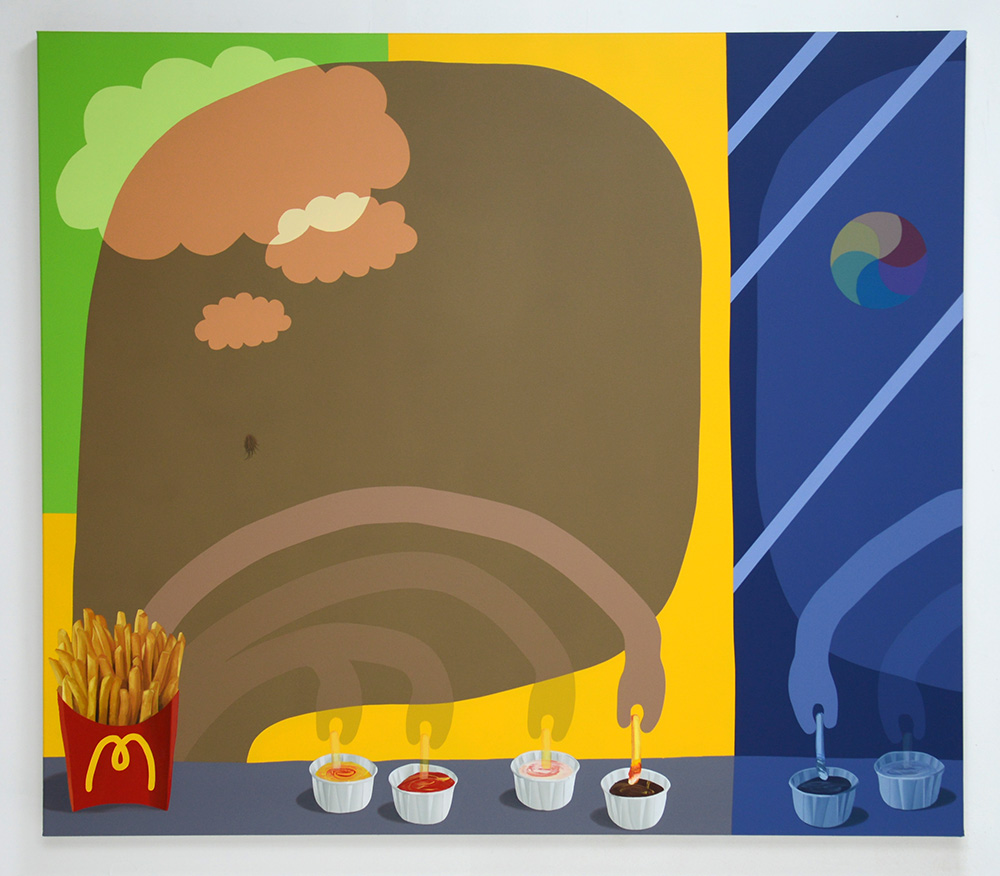
You’ve mentioned that you create optical confusion related to the blurry line between digital and real life. How much do you consider our dystopian present and future? Your paintings seem really positive despite hinting at Capitalistic perils.
I do posit a kind of dystopian outlook if you think about the way that my characters blur into one homogenous, faceless consumer. I consciously think about the direction we are heading, but in truth, my view is not at all negative. I wholeheartedly embrace a consumer lifestyle but I actively engage with it partly in life, partly through my paintings; my life and my work are a cycle in that respect. I’m always drawing inspiration from the things I do whilst participating in some of the more ridiculous rituals, such as artificial mid-November tanning in London. I’m always reflecting on what I’m doing and why I’m doing it. I don’t, therefore, think of myself as a passive consumer. I think constructing the self is a constant battle, and that’s what we’re all striving to do, but I celebrate our futile and brave attempts to pull it off.
Tell me about your Pride painting.
It’s about shame at pride.
Shame and pride are opposites.
Yeah, it is an antonym. The painting is about gay shame at Pride: the personal distress caused by the consciousness of being “wrong” or different. The character in the painting found the courage to show up to the march, doing his best to support the cause, waving the rainbow flag and holding a sparkler, however, he’s wearing a balaclava, hiding his identity.
The painting deals with these contrasting actions of wanting to show up to the parade, but not wanting to be recognized or outed. A lot of my work deals with these ironies, conflicting and co-habiting experiences. Not every emotion is black or white.
True. So, what’s the last thing you took a screenshot of?
Ha, I just checked. It was a spandex suit designed to look like a blow-up sex doll.
“Add to cart?” What other kinds of things do you collect?
I’m a big collector of things—little trinkets and oddities. I’m a regular car boot sale goer… but this last year, I have put 10% of my sales back into buying new art. I own small artworks by Misaki Kawai, Otto Ford, Jane Hayes Greenwood and Ryan Christian Travis. I’m excited to eventually frame them.
How’s life and art been going since you finished school last summer?
It’s been amazing. I feel so lucky to have just graduated and to able to paint full time. I have my collectors to thank for that. I hit the ground running after selling out my Degree Show at City & Guilds of London Art School. Since then, I’ve been approached by a number of galleries internationally. I’m currently preparing for my first solo show at Semiose Galerie in Paris.
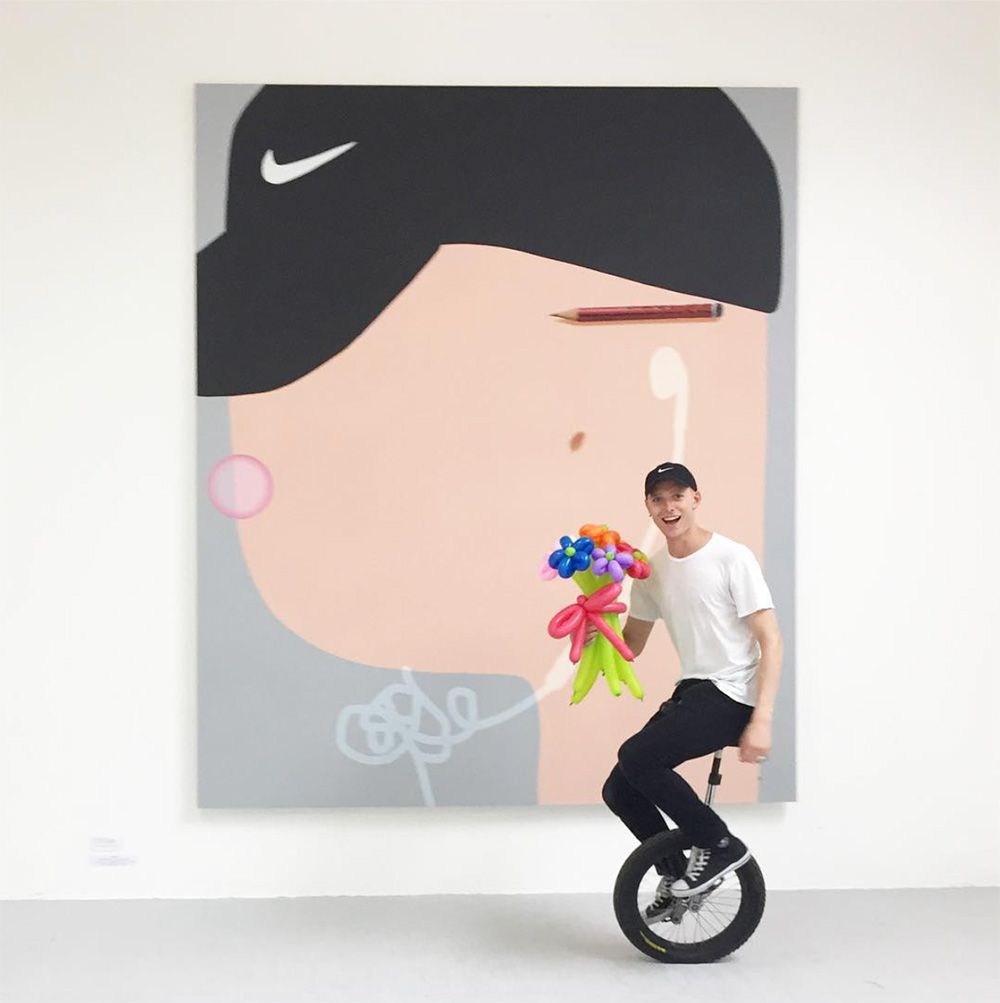
Tell me about it.
“The show is called Epiphanies. I’m using the term in its informal use—“a moment of sudden and great revelation or realization”—rather than the religious event. That said, however, it is a play on the manifestation of Christ (God incarnate). The bodies in my paintings hover between the real and not real, and they are adorned with material items, loosely recalling the gifts of The Three Wise Men. The comedy is in the use of a grandiose word to describe mundane observations, but in transforming those observations into paintings, I am raising their importance beyond the trivial.
Who’s your most famous collector so far, especially now that GQ has named you early blue chip?
They’re all special, and yes, I have some very exciting collectors on my waiting list, but for me, it’s not about that. The greatest honor is when a fellow artist wants to buy a painting, someone who has to break their piggy bank and save up for a few months to afford a work. For me, artists trump even the biggest collectors.
Which of your paintings are most revealing about your true self?
It has to be Multi Multitasking, a three-meter self-portrait I made, adorned with signifiers which are distinctly me. The chewed pencil behind my ear indicates anxiety and nerves, a Nike Cap to hide my receding hairline, a hairy mole, after Oliver Cromwell, who said, “paint me with my warts and all,” bubblegum, because I love artificial flavours, and tangled headphones because I’m a mess. I called this piece Multi Multitasking because of the joke that I’m not really doing anything in the painting, apart from getting lost in my own head, blowing gum and listening to Spotify.
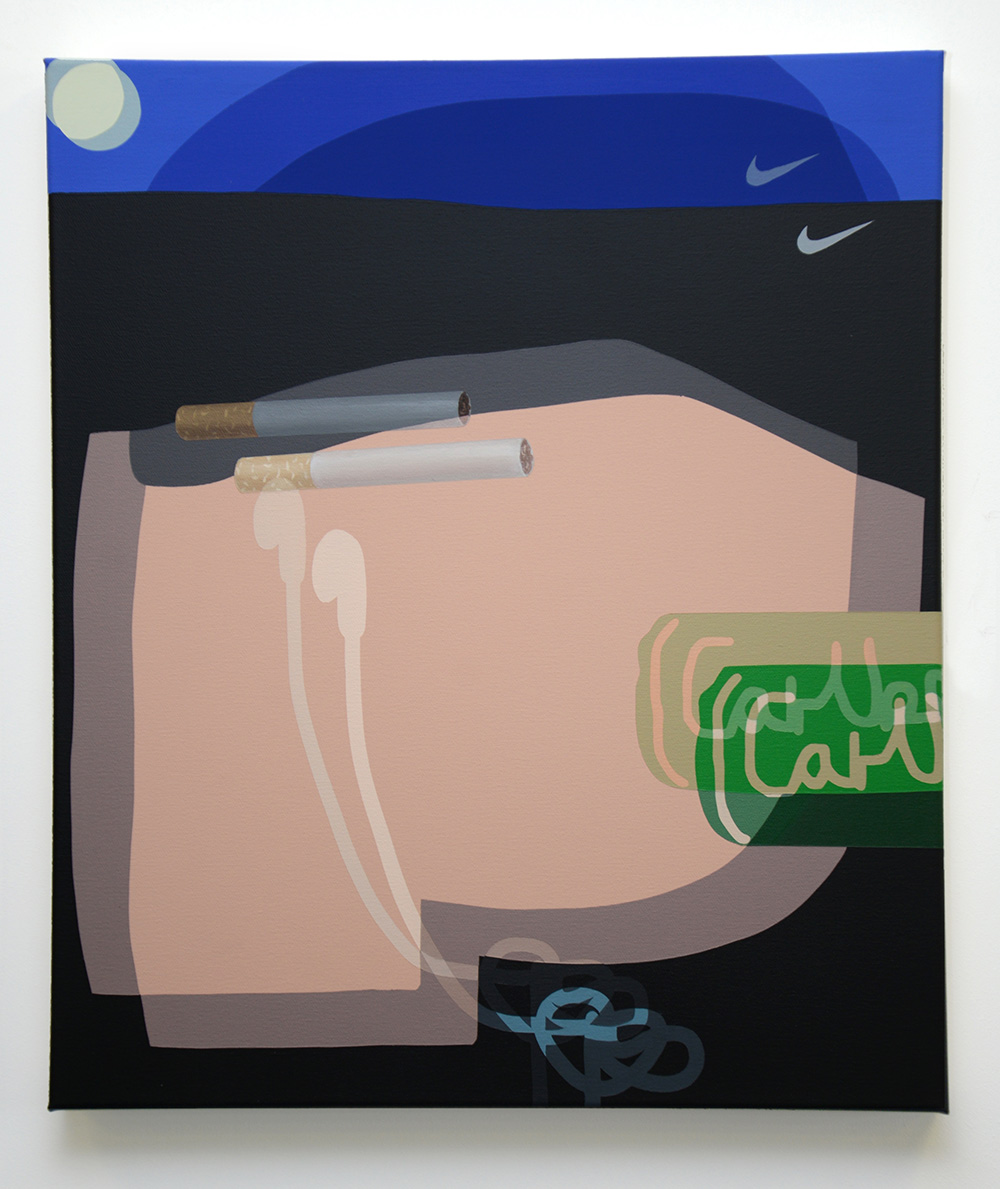
Listening to what?
“True” by Spandau Ballet.
What’s your favorite accessory?
It’s a ring I made when I was 18. People often mistake it for a class ring, but it’s actually a repurposed twenty-pence coin. I never take it off.
Describe the painting you’re currently working on.
It’s a drunk kebab shop painting called You Spin Me Right Round.
What’s your cocktail of choice?
Long Island Iced Tea—no class, no shame.
See Oli Epp everywhere in 2018. His show at Semiose Galerie, in Paris through June 9, 2018, sold out before it opened.
Oliepp.com

